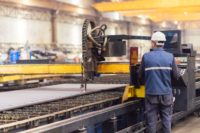Manufacturing employees often work near significant hazards, like heavy equipment, potentially dangerous chemicals and electricity. Safety has come a long way over the past few decades, but businesses can always do more to protect their workers.
New applications of IoT devices are making manufacturing environments much safer — and they may be on track to transform how the industry approaches on-site safety.
1. Wearables and cameras for monitoring and compliance
IoT technology can help managers more effectively track workers, allowing them to keep tabs on employee safety even while off-site.
Wearables, in the form of smart safety glasses, watches, hard hats and boots, can help guarantee worker safety while providing additional information to employees and managers. For example, a smart hard hat can contain accelerometers and GPS sensors to track a worker's location and detect sudden motions indicative of slips or falls.
The hard hat can also communicate with other devices in the IoT fleet. In the event of a fall, it can immediately alert nearby employees, helping to guarantee the fastest possible response.
The hard hat may also help prevent accidents before they occur. For example, it can send location information to heavy machinery, alerting the machine’s operator and the worker if the two come too close together — possibly averting a struck-by incident.
Other wearables can offer similar safety benefits. Smart boots can detect slips and falls using similar hardware. Smart glasses can display notifications about safety events as they occur.
Wearables can also help protect employees from unsafe working environments and hazards like exposure to toxic chemicals. For example, a smartwatch may be outfitted with chemical sensors, allowing it to alert the wearer and managers when dangerous levels of certain chemicals are detected.
Data from these sensors can also help manufacturers detect unsafe operating conditions. Suppose the system identifies high levels of toxic fumes, like those generated by hexavalent chromium plating. In that case, it can encourage the manufacturer or facility owner to adopt an alternative approach that poses less risk to workers.
Smart cameras supported by machine vision algorithms can complement these safety wearables. They can continuously monitor and analyze a site floor, observing machinery, workers and assets to detect safety incidents, noncompliance and potential workplace hazards.
2. Remote monitoring
Equipment failure can immediately create serious safety risks for nearby workers. Robots' arms can behave unpredictably, electrical components may spark fires or discharge, and moving parts can be sent flying. Safety equipment, like light curtains or motion detectors, can also fail, possibly making facility machinery much less safe for operators and nearby employees.
Even the least threatening failure modes come with significant downsides — like loss of productivity, downtime and potentially higher maintenance costs.
Remote monitoring can help managers foresee equipment failures and more effectively maintain essential equipment. With a combination of IoT devices, technicians and managers can track operational variables like temperature, vibration, timing, RPM and lubrication in real-time. This information can allow them to assess performance and catch failure or unusual machine behavior sooner than they could otherwise.
Data from IoT sensors can help managers improve equipment operations and streamline the use of factory equipment.
Remote monitoring data can also lay the foundation for AI-powered predictive maintenance and analytics. These algorithms use historical operational data and real-time information to predict machine upkeep needs and potentially avoid downtime.
3. Network existing facility and safety systems
Manufacturers can also use IoT to connect existing legacy systems — like fire suppression systems and facility HVAC — with each other, manufacturing management systems and the larger IoT fleet. This connectivity can help managers remotely access these systems and take advantage of the information they already produce.
For example, networking a legacy HVAC system may give a manufacturer direct remote control over vents, air conditioners, boilers and other equipment. Information from other IoT devices can help automatically control and manage these systems.
IoT devices can also expand the functionality of these legacy systems. For example, many businesses are experimenting with using IoT to improve fire suppression technology.
Temperature sensors distributed throughout a facility can improve HVAC performance and provide information during a crisis. By monitoring facility temperatures, manufacturers can detect potential fires earlier and track their spread in real-time, allowing for a targeted response from firefighters.
Similarly, temperature sensors can automate HVAC control, enable zoned heating and cooling, or provide additional information for a facility’s preventive maintenance system.
Improving site safety
IoT can be an invaluable asset for manufacturers looking to improve site safety. Using it to its full advantage can reduce workplace accidents and boost your productivity and reputation.
Alone or in combination with other Industry 4.0 technology, IoT fleets can provide critical safety information to managers and employees, helping to prevent safety incidents or minimize the risk many industrial hazards pose.



